Most of us dream of the relaxing beaches of the Caribbean, the historical extravagance of Europe, or, you know, other normal vacation spots. But for some travelers, adventure and an adrenaline rush are what they crave. And who really cares about relaxing when you could be risking your life, right?
We're not even joking. If you start thinking about it you'll come to the same conclusion as us: nobody wants to hear vacation tales that involve drama-free cocktail sipping on Italy's Amalfi Coast. There's no story there. Unless you have friends who want to hear all about every pizza you ate.
But would we risk our lives for a good story? Probably not! Hand us a cocktail and a bowl of pasta in Italy any day of the week. We might not understand what is going through the minds of these extreme thrill seekers, but it certainly makes for interesting reading. We hope these destinations both excite and terrify you!
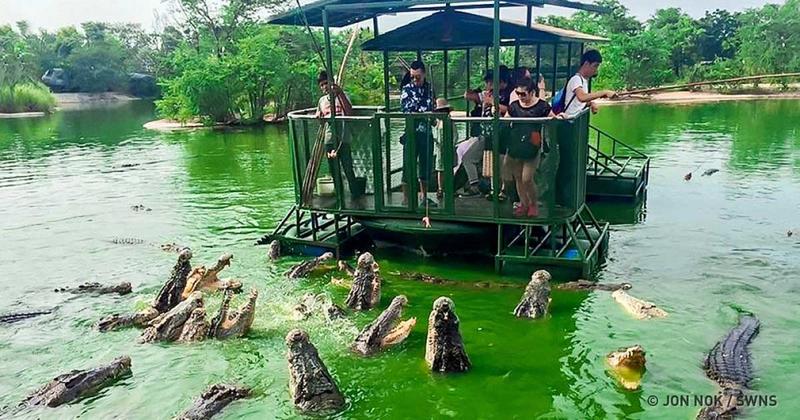
One of the world's greatest engineering feats, the four-mile Nanjing Yangtze River Bridge is truly a sight to behold. It is double-decked, with the China National Highway up top and the Beijing-Shanghai Railway on the bottom. Completed in 1968, the bridge carries a massive 80,000 vehicles a day, in addition to 190 trains. If you're cruising the Yangtze River, this bridge is a must-see attraction.

We bet you're waiting to hear what danger might befall you if you cross the bridge. This is definitely a dangerous spot, but not for the reasons you might think. The Nanjing Yangtze River Bridge is actually the most frequent suicide site in the world, with more than 2,000 people ending their own lives there since its opening in the 60s. It's definitely not somewhere we've got on our bucket lists.
When you think of the beaches of Acapulco, you probably imagine old school 50s glamor, luxury resorts, perfect weather, palm trees, and everything else synonymous with paradise. Back in the day, Acapulco was well known as a tropical playground for the rich and famous, but the party definitely came to an end.
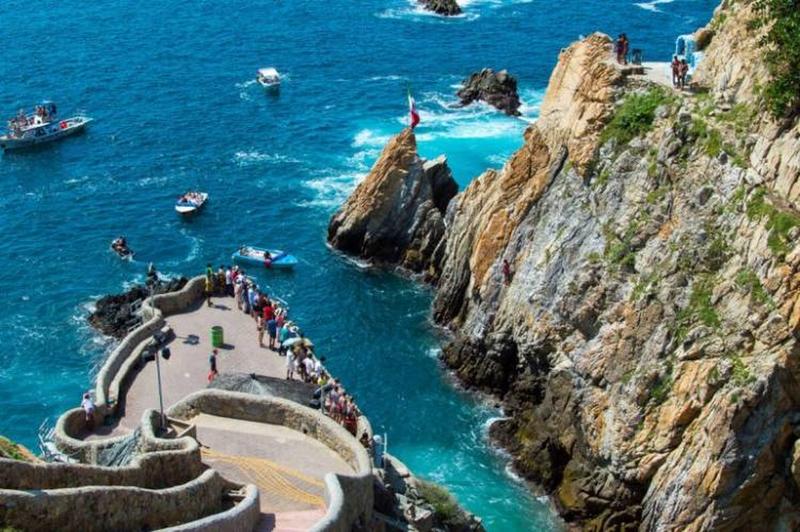
The beautiful beaches remain unchanged, but the atmosphere of old has been replaced with something new. Mexico's drug war has come at a price, and Acapulco has been caught in the middle. Where before there was tranquility, now there is gunfire between rival gangs. In fact, Acapulco is now the second most dangerous city in the world. Some daring tourists still visit, but the risk of being kidnapped, raped, or murdered has increased drastically. If you're going to go, stay in a safe resort area.
Seeing England on this list has probably surprised you, but don't be fooled, danger lurks where you'd least expect it. As with Acapulco, this garden is beautiful, yet potentially deadly. At first glance, the luscious roses, spectacular water features, and immaculate lawns provide you with a false sense of security. Then you're met with a sign that brings you straight back to reality: "These plants can kill you."
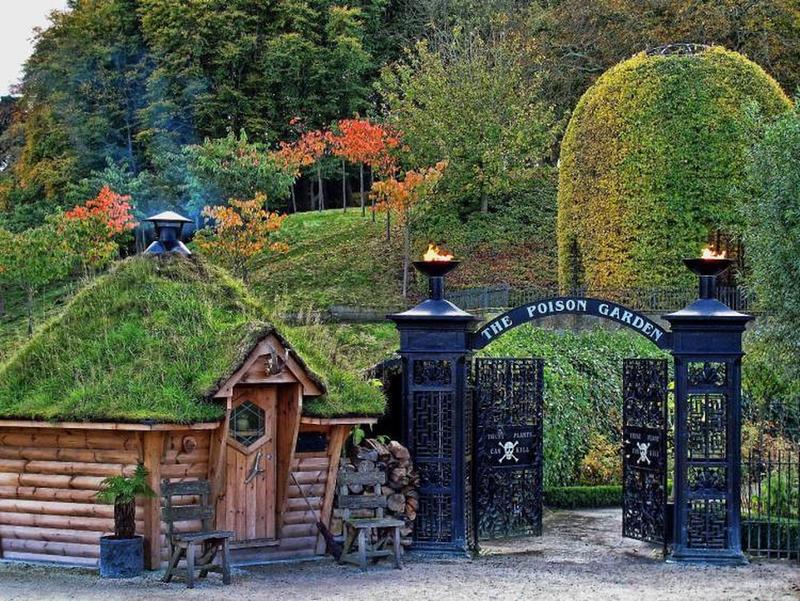
Alnwick Gardens is well known as the 'poison garden' and is home to more than 100 deadly plant species. With killer plants including Conium Maculatum, Strychnos nuxvomica, and Atropa belladonna, it's no wonder this deceptive garden is the most dangerous of its kind in the world. The garden also plays host to a crop of coca leaves, the main ingredient of the infamous narcotic, cocaine. Enter at your own risk!
While we're sure northern Ukraine isn't super high on most bucket lists right now, we thought we better mention it, just in case. Located 65 miles north of Kiev, the Chernobyl Nuclear Power Plant near the city of Pripyat was the site of a major nuclear disaster that has left the area way too dangerous to visit for many years. In 1986 a huge amount of radiation was released into the air, due to a test that went horribly wrong.
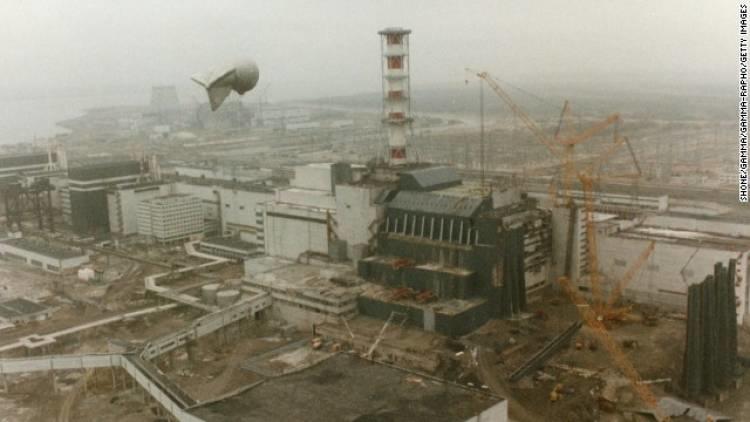
The city of Pripyat was evacuated and has been abandoned ever since. The high levels of radiation in the air meant many succumbed to thyroid cancer as a result, as well as other conditions caused by radiation exposure. You might be thinking, 'who would want to go here?' but, as usual, there have been tourists queuing up to explore. Ukraine opened up the area around the plant to tourists in 2011.
Yosemite National Park is one of the jewels in California's crown. Located at the Sierra Nevada Mountains, it is often quoted as one of the most beautiful areas in North America. And if you see pictures, you'll understand why. Home to rivers, lakes, luscious plants, waterfalls, stunning hiking trails, and unique wildlife, Yosemite sounds like a nature lover's paradise. But don't be fooled by the photos - stepping into this national park involves risking your life.
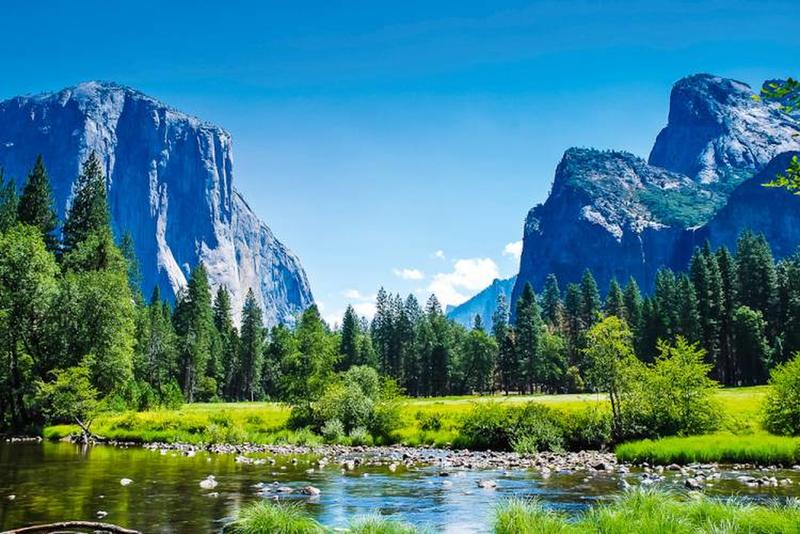
Vernal Fall, at a height of 300 feet, is a gorgeous yet deadly waterfall, responsible for multiple tourist deaths. This isn't because people decide to jump off, but because the river has an unexpectedly strong current. By the time people get in for a swim, it's too late. Of course, we haven't even mentioned the 500 black bears that call Yosemite home. Or the rattlesnakes!
Originally famous as a battle ground between Australia and Japan in World War II, the Kokoda Trail now enjoys new fame as one of the best and most adventurous hikes in the world. Located amongst Papua New Guinea's lush rainforests, the Kokoda Trail is downright picturesque. But it does have a dark side. Extreme weather, dangerous wildlife, uncertain terrain, and hostile natives make the trail a risky undertaking for tourists attempting the ambitious trek.
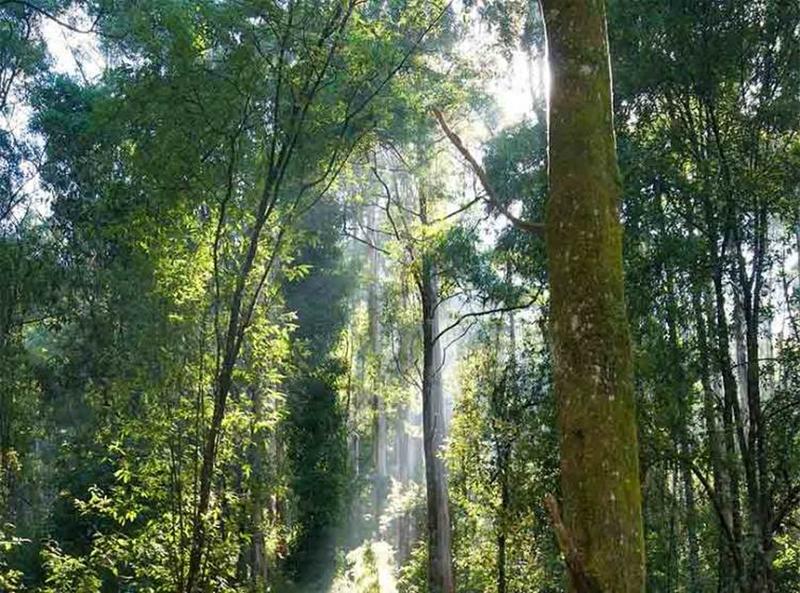
Hikers have reported being attacked with machetes by local tribes, particularly if tensions between the various villages are high. Life-threatening dehydration, swimming across streams full of deadly creatures, and succumbing to malaria are more things you can look forward to if you decide to take on Kokoda. And that's just what we've heard from the ones who make it out alive...
Anyone who has experienced it will tell you that Colorado River, which flows through Nevada, Utah, California, Arizona, and of course, Colorado, is one of the earth's most stunning natural wonders. At 1450 miles long, the river has long been a popular destination for whitewater rafting across multiple states. However, the death count is high and you'll be gambling with your life every time you get into that raft.

While many deaths can be put down to inexperience, and stupidly, alcohol consumption, even the most sensible and knowledgeable rafters are susceptible to fatal incidents controlled only by Mother Nature. The Colorado River is known for unpredictable and heavy rains that cause water levels to rise suddenly. Add melting snow from the nearby mountain ranges to the mix and you've got yourself a recipe for disaster.
Located in County Clare, Ireland, the Cliffs of Moher are a truly mind-blowing sight. The stunning cliffs, with their even more stunning views are Ireland's second most visited attraction, and it's no surprise why when you look at the photographs. Rising 400 feet above the Atlantic Ocean, the sandstone Cliffs of Moher are gorgeous, yet potentially fatal to tourists. Though you wouldn't expect it from such a major destination, the cliffs do not have any safety rails.
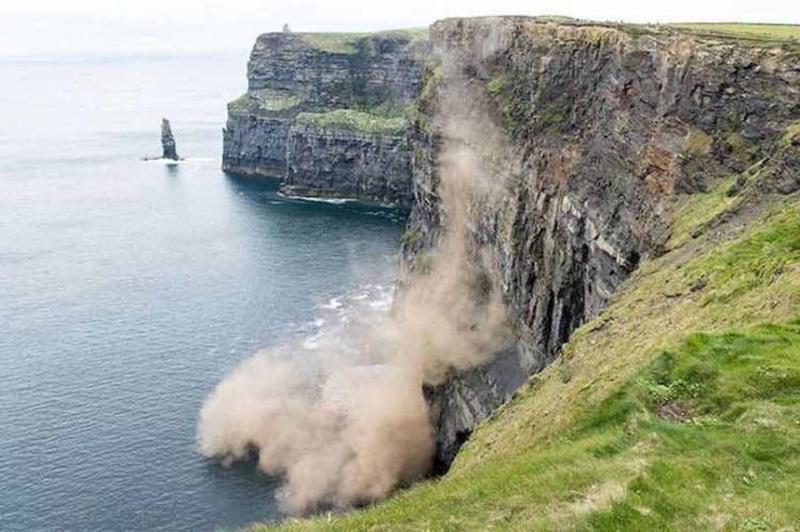
Who needs safety rails? You might be wondering. And it is all good and well for the most part. Until the notorious strong winds pick up and you're swept over the side, that is. Unpredictable rains and loose terrain also add an element of danger to wandering too close to the edge. Because of the lack of safety rails, this location is also a very popular suicide spot.
Most people who visit Lake Natron in Tanzania can barely believe their eyes - it's almost totally pink! Home to matching pink flamingos, it's obvious why so many people want to see this amazing salt and soda lake for themselves. But it's not all pretty in pink - Lake Natron has an unusually high alkaline content and a pH level of 10.5, which is the same as ammonia. To put it simply, Lake Natron will burn the skin off humans and most animals.
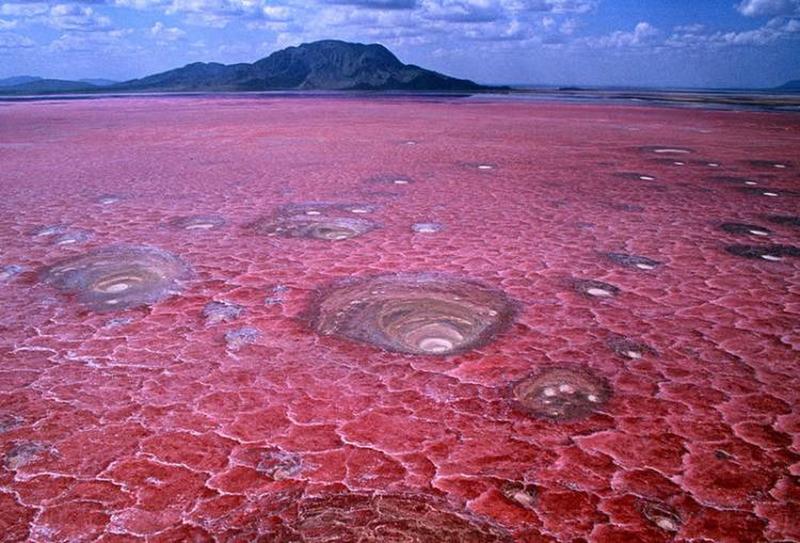
In addition to the whole skin burning thing, temperatures around the lake can reach a whopping 60 degrees Celsius (140 Fahrenheit). Basically, the only thing that can survive here are the flamingos. The lake is made up of both hydrogen and sulfide, so most animals will die as soon as they touch its waters. And yes, that includes human travelers, too!
Just looking at photos of this apparent paradise makes you want to quit your job and run away to a life of tropical bliss. Bikini Atoll is a UNESCO World Heritage Site and extremely popular with tourists who have the cash to spare. But just like all the other things on this list, not everything is what it seems here. Between the years of 1946 and 1958 the USA made Bikini Atoll its testing ground for nuclear explosives, causing it to become full of radiation.
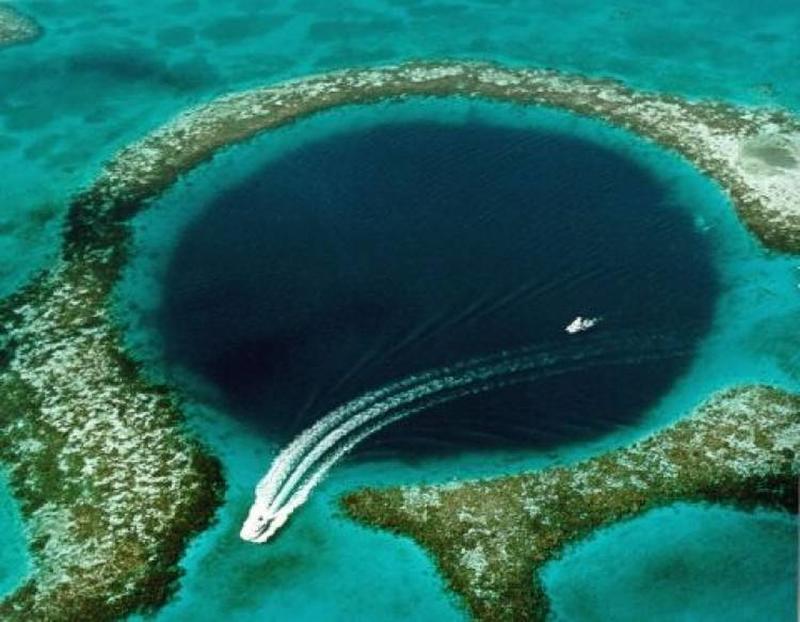
Though it was declared radiation-free back in the 80s, most living things, including plants and sea life, are contaminated. As you can imagine, when the soil is contaminated, growing food becomes dangerous. Locals reported large numbers of birth defects and abnormalities and many ended up leaving their island homes permanently.
Better known as 'El Camino de la Muerte' by locals, Yungas Road, or 'Death Road' in Bolivia is notorious all over the globe. Stretching for 43 miles and winding around breathtaking hills, the road is both extremely gorgeous and extremely dangerous. Around 300 people die on Yungas Road every year, which is obviously where it gets its ominous nickname. It is officially one of the most dangerous roads in the world, but that fact doesn't stop the hordes of people who want to experience riding it.
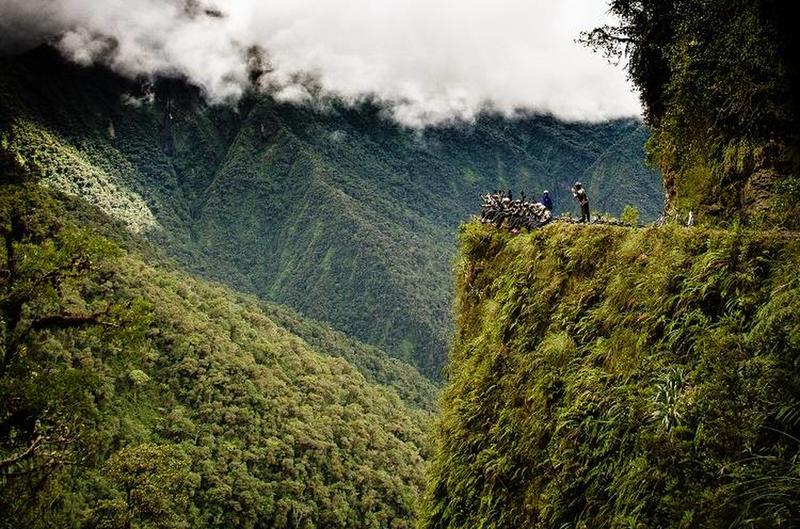
The Amazon Rainforest is beautiful to look at, but would you really want to fall into its canopies to a gruesome death? Yungas Road is single-lane and you can forget about safety railings. One wrong move and you'll join the statistics. In addition to this, there are often severe mudslides in the area during the wet season.
We've just had Death Road, now let's look at Death Valley! Often cited as the hottest place on earth, Death Valley National Park in California and Nevada records the most consistent high temperatures in the world, so we think it deserves the title. If 134 degrees Fahrenheit sounds good to you, by all means, get yourself over there for some hiking - just remember to take plenty of water.

We're not joking about the water either. Due to the extreme weather, humans can only survive for about 14 hours there without any fluids. You might be thinking about taking a trip during winter instead, but the temperature goes pretty much in the opposite direction then and it can be freezing. Don't forget that sudden flooding can occur in the valley, making it a literal death trap for anyone unfortunate enough to be there at the time.
Located in Spain's picturesque Malaga province, El Caminito del Rey is a jaw-dropping, cliff-hugging trail that would send most of our hearts racing. The English translation of the name is "the king's way" but we have to wonder what kind of king would be satisfied with such an adrenalin-inducing path. Five miles long and three feet wide, the path hovers 300 feet above solid ground, attached to the side of El Chorro cliff.
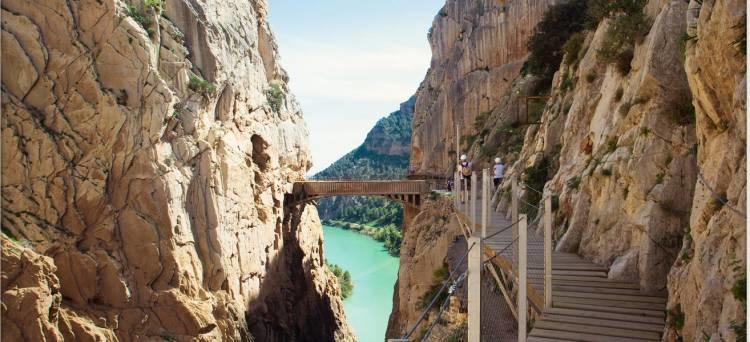
You'd think the threat of vertigo, peeing your pants, or, you know, falling to your untimely death would stop people, but that hasn't been the case at all. Every year more than 600,000 thrill seekers arrive to experience the terror that is El Caminito del Rey. You guys do what you like, but we think we'll definitely be sitting this one out!
Isolated, rugged, and breathtakingly gorgeous, Skellig Michael in Ireland is like an image you could only conjure up in your imagination. In fact, it's so unreal that it has actually been a filming location for blockbuster fantasy and sci-fi films, including Star Wars. The site was discovered by monks many years before any of us were born and they chose it specifically because of how difficult it is to access. They certainly weren't messing about - Skellig Michael is so hard to reach that you'll be risking your life by attempting the journey.
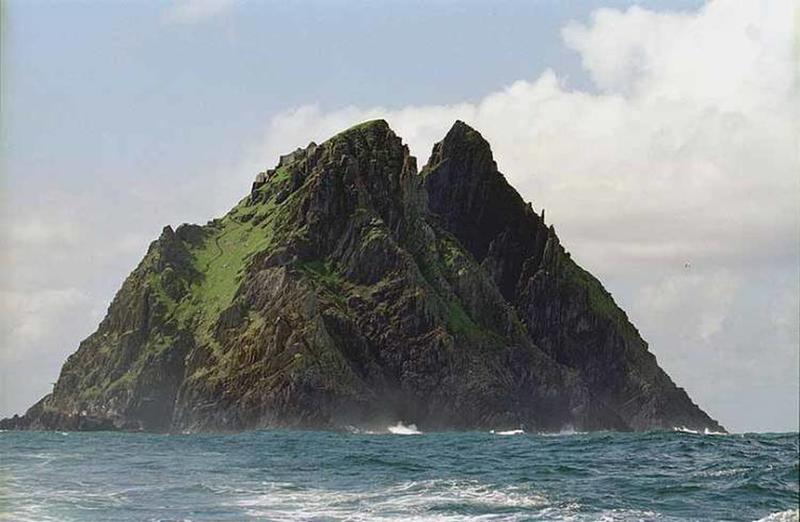
As a UNESCO World Heritage Site, this beautiful, craggy rock has attracted thousands of tourists. But the only way to get there is by taking a one-hour boat ride across rough ocean, with very high waves. Once you get there, the slippery thousand-year-old stairs are another hurdle.
With its clear waters, white sand, proximity to some of Brazil's best nightlife, and perfect sunsets every day, it's no wonder Praia de Boa Viagem is one of Northern Brazil's most popular beach destinations. Just looking at photos of this hot spot is enough to make you want to get out your credit card and book your flights. But there's a dark side to this gorgeous stretch of ocean.
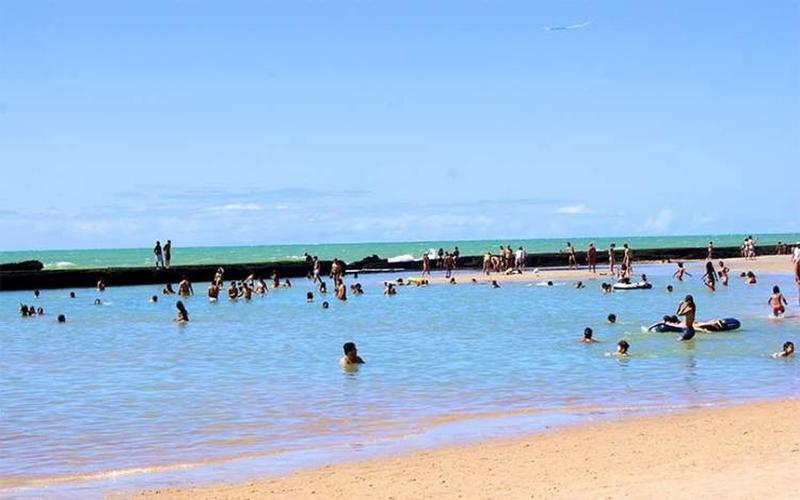
Praia de Boa Viagem is one of the planet's most dangerous places to go swimming, but you would never guess just by looking at it. It is notorious for frequent shark attacks, with more than one third of them ending in painful and terrifying death. All the best restaurants and nightclubs in the world wouldn't be able to make us go swimming in these waters, even if they are absolutely stunning.
If you thought Praia de Boa Viagem in Brazil sounded bad, just wait until you hear about New Smyrna Beach in Florida, USA. Named the 'shark attack capital of the world' by the Guinness Book of World Records, we're struggling to come up with reasons why anyone in their right mind would want to take their chances swimming here.
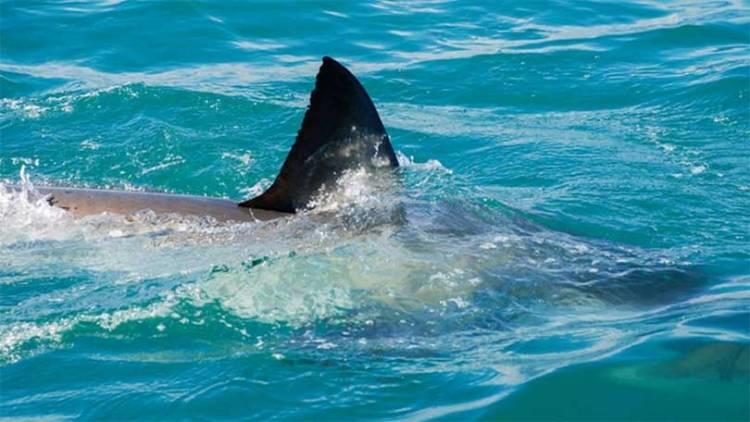
With around 240 recorded attacks having taken place at New Smyrna, it's not hard to see where it gets its scary title from. If you thought Australia and South Africa were more dangerous for shark bites, you'd be wrong. Most people who swim in New Smyrna get within three meters of dangerous sharks lurking in its waters. Visibility is poor, so swimmers, as well as the sharks, have no idea what is about to hit them.
When you think of the most dangerous places on earth, France doesn't really pop up as an option. More famous for wine and croissants, we tend to think of slightly less developed locations than France instead. But that's because most of us have never been to Mont Blanc. With peaks of up to 16,000 feet high and wind speeds of up to 60 miles per hour, this mountain is both stunning and potentially deadly.
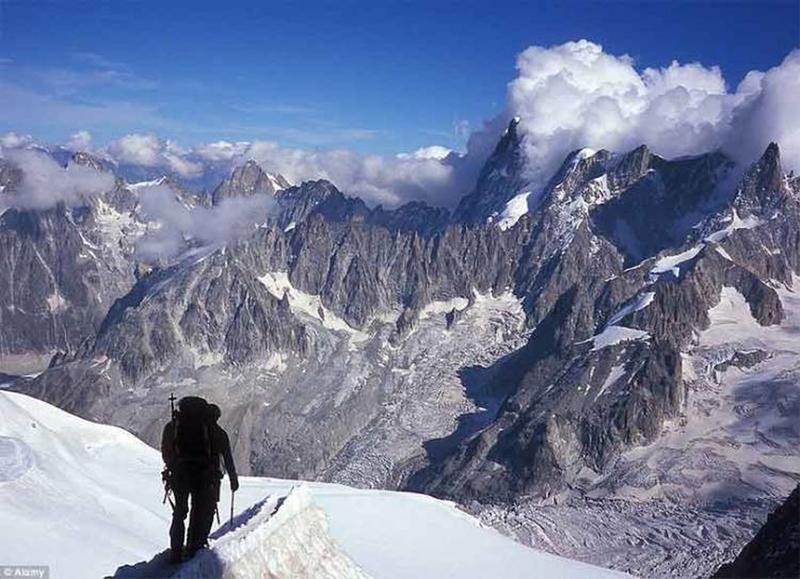
It's not just extreme winds and precarious heights posing a risk - avalanches are also very common in the area, making it even more dangerous to those who visit. Of course, this doesn't stop tourists from flocking to see Mont Blanc. Accidental death is common, but even more common are life-altering injuries. We'd opt to stay home, but if you're going to go, be careful!
As the world's highest mountain, it's not really a surprise to see Mount Everest on this list. Obviously, anything this tall is going to cause some complications, especially given how compelled humans are to conquer everything they lay eyes on. Most of us are happy to admire Mount Everest from the comfort of a Google Image search, but for the adrenalin junkies out there, this would never be good enough.

Often seen as one of life's greatest challenges, plenty of people have attempted to make the climb to the peak. Unfortunately, almost 300 people have died during their attempts, and it's always an unpleasant way to go. Whether it's avalanches, falling rocks, lack of oxygen, altitude sickness, extreme weather, or inadequate supplies, Mount Everest always seems to find a way to make death very terrifying indeed.
Indonesia is a super popular destination for tourists, particularly its most famous island, Bali. However, recent times have seen some other Indonesian islands get a little more attention, including Sumatra, located to the west of the country. As one of the biggest islands in the world, Sumatra is home to all kinds of nature and wildlife, including Mount Sinabung Volcano, which didn't cause any problems until recently.
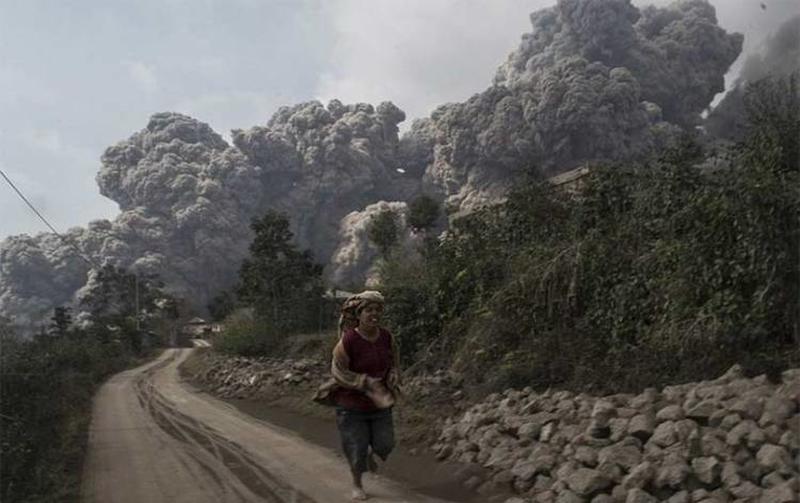
Mount Sinabung Volcano was dormant for more than 400 years before suddenly springing back to life in 2010. Unfortunately, this was right around the time tourists started noticing the little-visited island and planning trips to see it. Since then, deadly eruptions have occurred almost every year, causing locals to lose their homes and lives. Whole villages have been left completely covered in lava and ash, so visit at your own risk.
We've just finished talking about staying away from volcanos in Indonesia, so you might find it difficult to believe that in Hawaii, people pay hundreds of dollars to be taken directly to the glowing hot center. Known for its Volcano national parks, Hawaii is considered a relatively safe place to view all of the action. But volcanos are unpredictable and we wouldn't be taking our chances with potential eruptions of molten lava.

We haven't even discussed the dangerous gases present if you do decide to visit volcanos located in Kilauea, Pahoa or Halema'uma'u in Hawaii. A toxic combination of hydrogen sulfide, hydrochloric acid, and carbon monoxide are three other compelling reasons to stay away if the piping hot lava didn't convince you. We think we'll save our money and relax by the pool with a cocktail instead!
Ever wanted to hike on a precariously high trail made up of a single plank of wood? No, neither have we. But for some reason, the tourists can't get enough of it. All you have to do is look at photos of Mount Huashan's famous hike to give yourself a case of vertigo. This cliffside trail is perched 7,087 feet in the air and leads to a temple and tea house. Though most of us would prefer more than a cup of tea at the end of such a feat, there are plenty of people who attempt it every year.
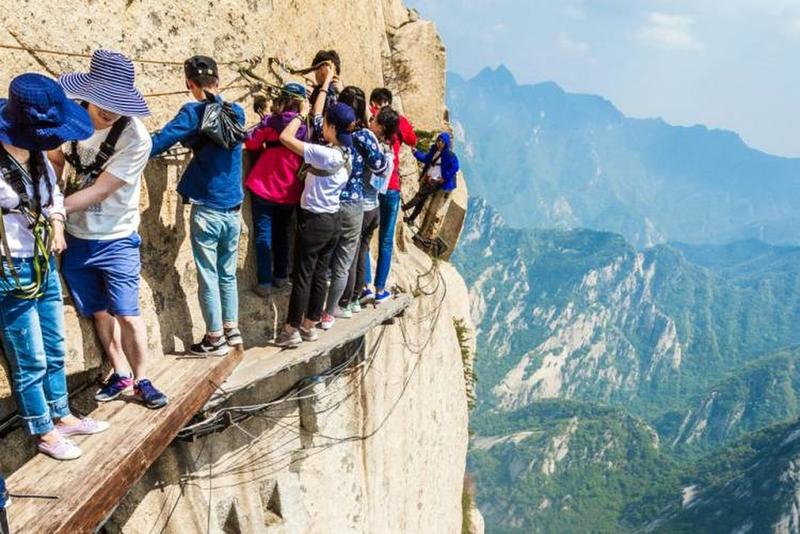
Traditionally, the trail was only frequented by monks and nuns, as a way to show their dedication to their faith - it's the only way to reach this extremely out of the way temple. But tourists have since caught on to the trail's existence and the death toll doesn't seem to bother anyone. No official statistics are available, but around 100 people fall to their death every year.
Depending on your experience, Madidi National Park in Bolivia could be something from your wildest dreams or most terrifying nightmares. Lush forests and flowing rivers make this park a hiker's fantasy, but it has the potential to turn deadly in the blink of an eye. Flesh-eating bacteria and murderous wildlife are just some of the obstacles that stand in your way.
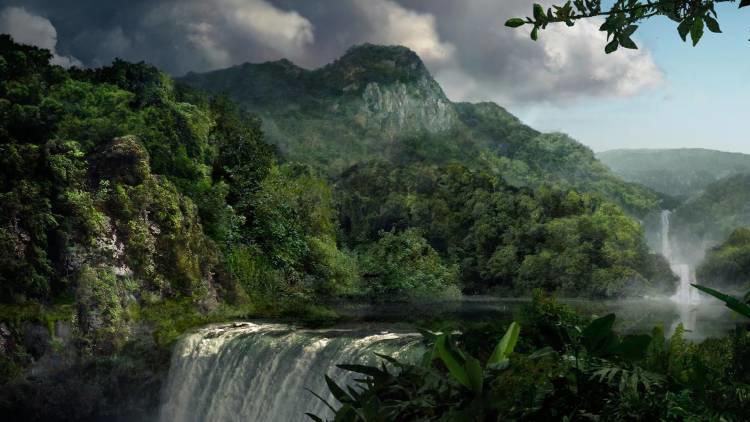
We're honestly not joking about the murderous animals. Within Madidi lives an infamous pack of wild pigs that will attack humans and literally rip them to shreds. Even if you manage to elude these horrifying creatures, more danger awaits. A small cut on your finger could be infected with parasites within minutes, making a fairly run of the mill injury the beginning of your untimely death. The Amazon is a natural wonder, but is it worth your life?
Located in Wimberley, Texas, Jacob's Well is somewhat of a natural phenomenon, and a deadly one at that. It is the largest underwater cave in the state, and if underwater caves aren't enough to scare you, maybe the fact that it can swallow professional divers whole will. Jacob's well might look like a peaceful spring from the outside, but it's actually an impossibly deep, black hole containing four chambers measuring 190 feet.
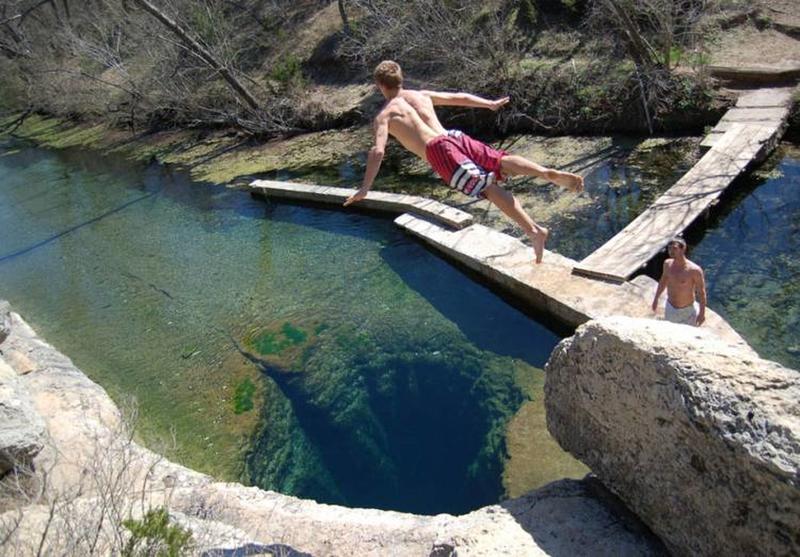
Ten known divers have been taken by Jacob's Well, and that's just the ones we know about. What most thrill seekers don't realize is that the chambers become tighter the further you go down. It's highly likely you would be trapped within the depths and never be seen again. For those who really want to see it, there's definitely nothing wrong with just dangling your legs in for a minute.
Stretching from north eastern Ethiopia to southern parts of Eritrea, the Danakil Desert is one of the most dangerous places you could ever visit. So dangerous, in fact, that it's well known as 'Hell on Earth'. This salt wasteland is exactly the kind of place we should be avoiding, but of course, nothing of the sort is happening. Tourists are still showing up to experience the blazing hot temperatures and risking their lives in the process.
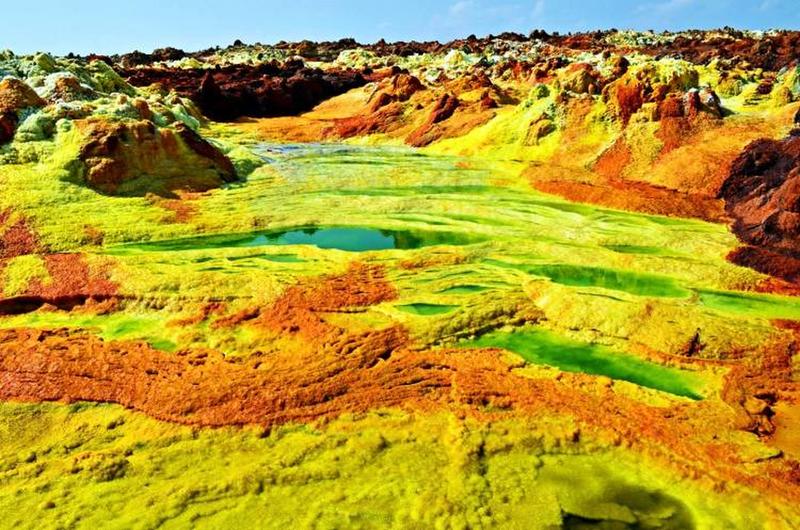
Active volcanos, gassy geysers, a lack of oxygen, and temperatures of around 120 degrees Fahrenheit are all the things you can look forward to if you decide to visit 'Hell on Earth'. If you manage to survive all of this, there are also the hostile rebels to look out for. Basically, don't go here if you value your life.
Would you really want to visit somewhere that the locals refer to as the 'Gateway to Hell'? Erta Ale Volcano is just one of the terrifying features within the Danakil Desert in Ethiopia. At more than 2000 feet high and 120 degrees Fahrenheit, Erta Ale is one hot spot you don't want to visit. It's one of the few active volcanos in the world, but it's the only volcano in the world with two active lava lakes, making it one of a kind.
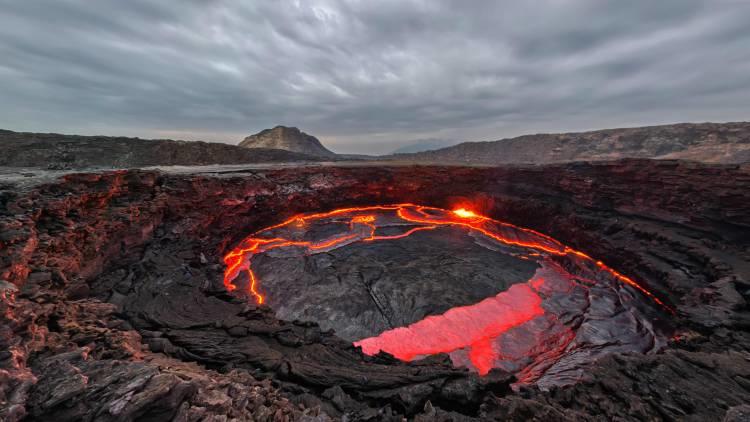
It's no surprise that people want to view this phenomenon for themselves, but it does come with risks. It's so dangerous due to the heat (and lava!) that the only way to view it is by helicopter. So, as you can imagine, this is an activity for those of us with plenty of cash to spare!
They don't call it the Devil's Pool for no reason! This naturally formed rock pool is located at the very edge of the majestic Victoria Falls on the Zambia side (the other side of the falls is in Zimbabwe). Some tourists are daring enough to swim in it. Some go even further and dangle their legs off the side. Swimming can only take place between September and December when a natural rock barrier forms, but it is still extremely dangerous.
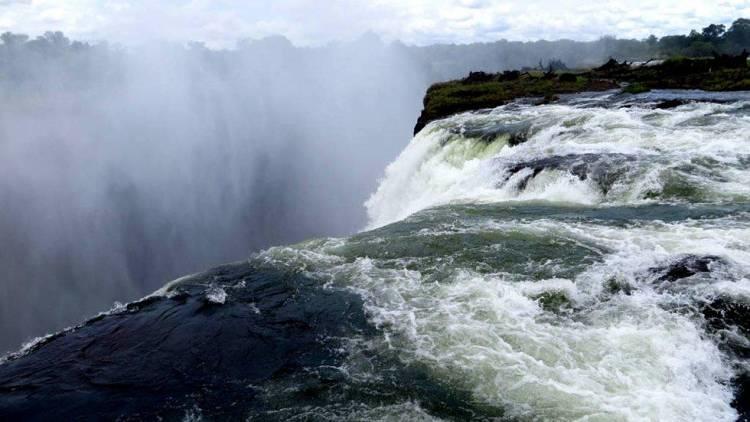
Several people have plunged to their death from the Devil's Pool, including one famous tour guide, who managed to save one of his charges who had started to fall. Unfortunately, he slipped during the rescue and lost his own life instead. You can marvel at the beauty of Victoria Falls without risking your life, so why not do that?
Located at Twin Falls, Idaho, the Perrine Bridge doesn't look like anything particularly crazy when you first lay eyes on it. At 1,500 feet long and 486 feet high, it's not unlike many other bridges in the country. The thing that distinguishes it from the rest of the pack is that it's the only man-made structure in the USA from which people can BASE jump without a permit all year round. Because of this, it's internationally famous and attracts BASE jumpers from all over the world.
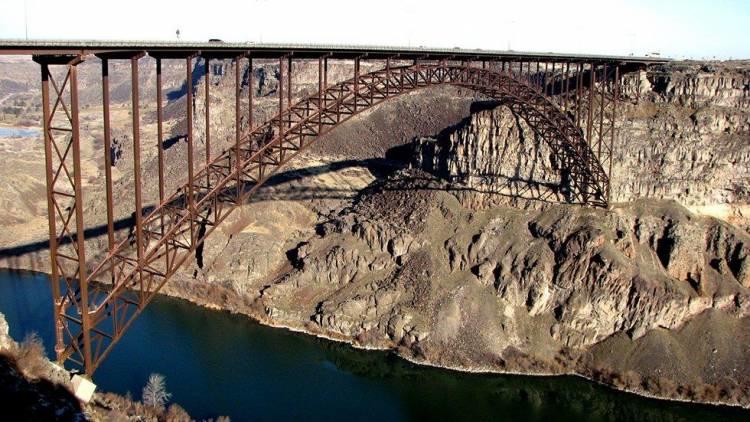
As you can imagine, BASE jumping is extremely dangerous, and numerous deaths have taken place at the Perrine Bridge. If things didn't already sound ominous, maybe the fact that it crosses the 'Snake' River will convince you to stay away. We strongly recommend knowing what you're doing before you make the jump.
Long considered one of the most extreme locations for whitewater rafting in the world, the Zambezi River is not one to take lightly. The stones and trenches that often leave boats unturned are just the tip of the iceberg when it comes to the dangers you'll face. Each section of rapids has its own name, which you might think is cute until you hear what they're called. Would you raft anywhere named 'Devil's Toilet Bowl', 'Boiling Pot', 'Gnashing Jaws of Death' or 'Overland Truck Eater'? If not, then you can give Zambezi a miss.
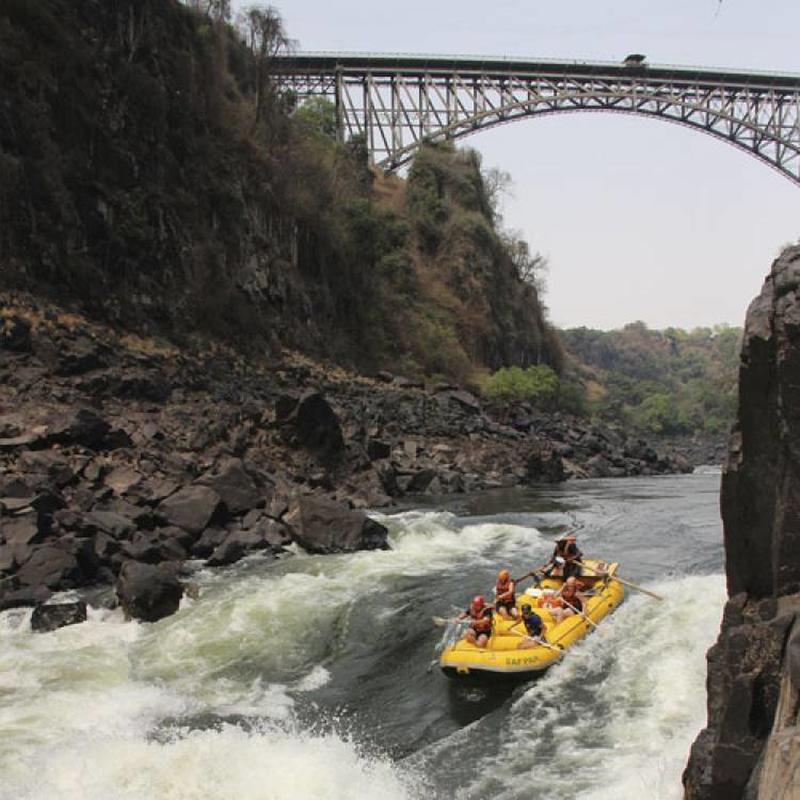
In addition to all this, you've also got the river's natives to worry about - crocodiles and hippos are common in the Zambezi, and they're not exactly considered friendly locals. We know we won't be able to hold any adrenalin junkies back, but at least you have all the facts now!
When you think of Switzerland, mountains certainly come to mind, but they're usually the lovely, green mountains you see in the movies. The Eiger is definitely not a friendly green mountain from the movies. It's actually almost the opposite. Known in Switzerland as 'Mordwand' (which translates to 'murder wall' in English), this mighty mountain has claimed more than a few lives in its time.
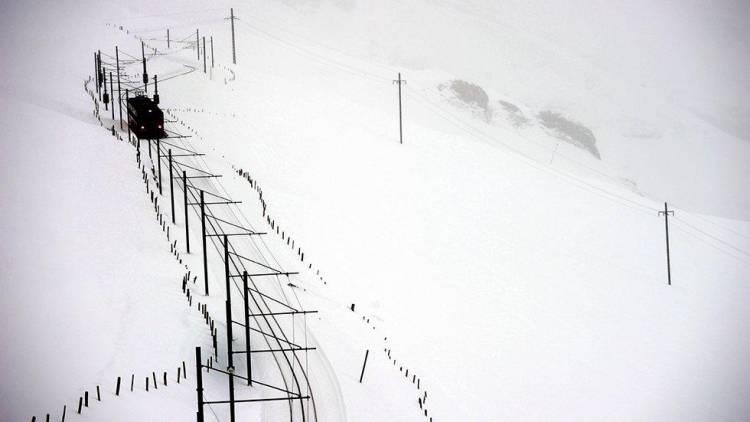
Located in the Bernese Alps, The Eiger is known as one of the most treacherous climbs in the world. At 13,000 feet, it would be technically tough at the best of times, but climbers also have to worry about frequent rock fall and avalanches. It is also becoming increasingly dangerous as climate change continues to melt the snow. Climate experts have predicted that it might be impossible to climb in a few years.
Pulpit Rock, also known as Preacher's Pulpit or Preikestolen, is one of Norway's most popular attractions. Just a photo is enough to wow most people. But views like this don't come without risks. It's a terrifying 1,970-foot drop into the fjord below, and in case you didn't notice in the photo, there are absolutely zero safety railings to speak of. Anyone daring enough to climb up here is gambling with their life.
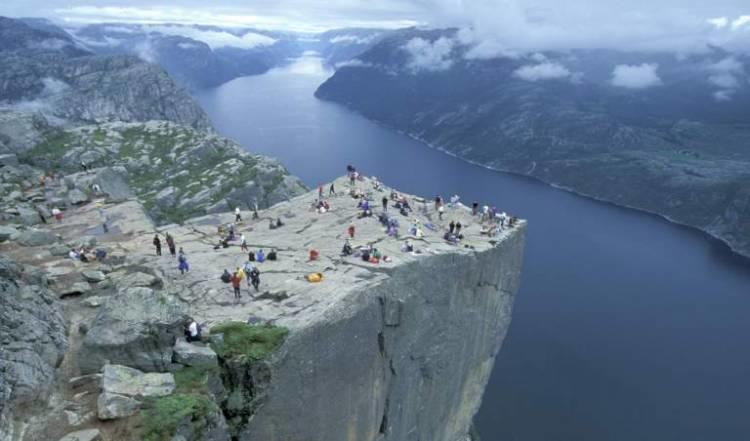
This hasn't seemed to hold anyone back, with more than 200,000 people making the climb each year. In fact, most people seem pretty casual about it and even take ridiculously dangerous selfies to prove to the world they were there. We haven't even mentioned the precarious climb to the top, which takes up to three hours and requires a lot of balancing skills.
Situated on the border of both Rwanda and the Democratic Republic of the Congo, Lake Kivu is one of Africa's largest and most important lakes. 'Majestic' seems like an understatement when you're trying to find the words to describe it. But tales of swimmers being swallowed whole and dead fish mysteriously appearing on the surface give us a different picture of what lies beneath.
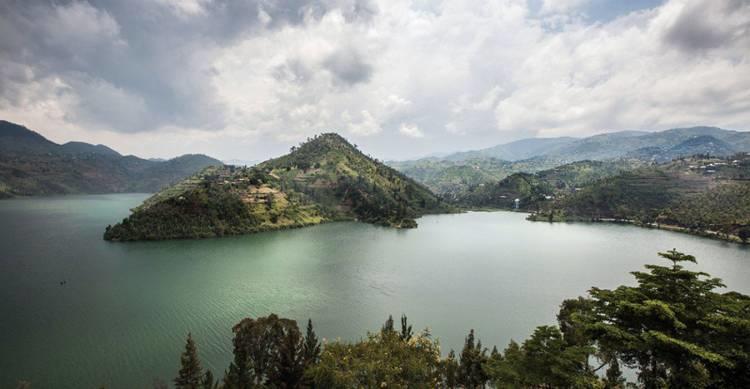
Lake Kivu has fascinated scientists in every field due to the methane gas trapped in its depths. If the gas is ever released, it would spell untold disaster for everyone and everything in the vicinity. All it would take is one volcanic eruption to pop this lake like a bottle of champagne, which exactly why the experts refer to this possibility as the 'champagne effect'. We'd advise steering clear if you value your life.
With a terrifying 800-foot drop to the fjord below, you have to be a real daredevil to step foot onto Kjeragbolton in western Norway. Either that, or you really love a good photo. Wedged between two cliffs on Kjerag Mountain, this feat is not for the faint of heart. Being Norway, wet weather is frequent, and can make the boulder slippery, increasing your chances of falling to a very scary and untimely death.
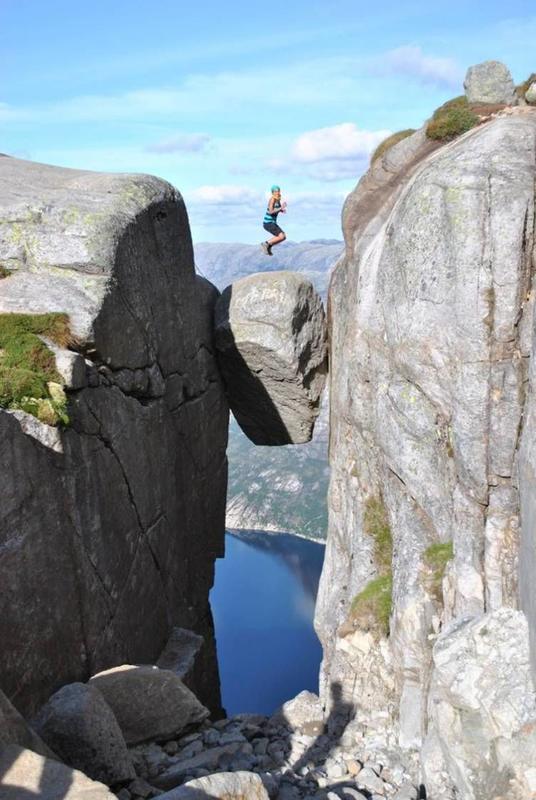
Don't forget that it's quite a climb making it up to the boulder. When your legs are shaky from a hike, the last thing you should be doing is a death-defying act. Unusually for Norway, the climb up includes metal chains as safety rails in the most dangerous spots, but this is about as secure as it gets if you're attempting Kjeragbolten.
Swinging above the Hunza River in Pakistan, Hassaini Bridge is known as one of the most dangerous bridges in the world. Constructed out of thin ropes and planks, it barely holds up against the extremely windy weather in the area, making it a potentially deadly crossing for anyone who takes the risk. Situated right by the village of Hunza, locals claim that Hussaini has claimed multiple lives in the past.
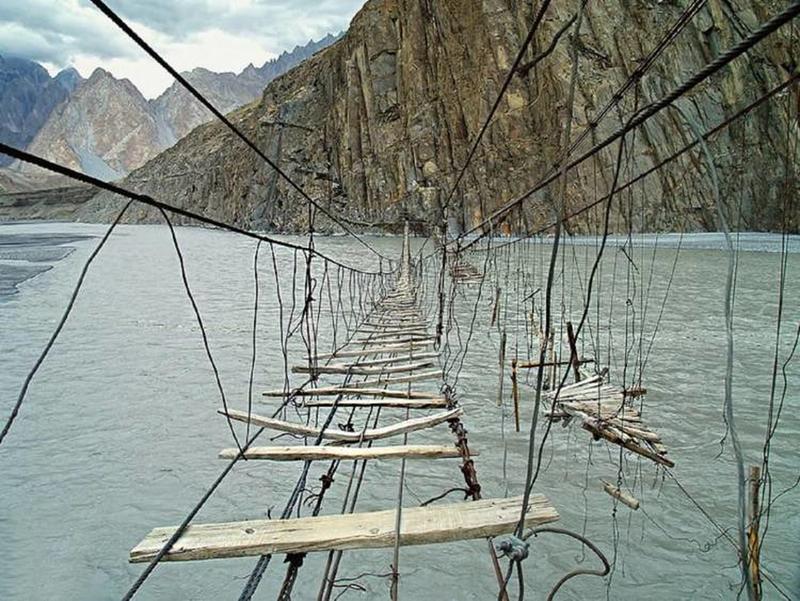
It's not uncommon for several planks to become dislodged on the bridge before somebody fixes them. While the crossing is a dangerous daily task for locals carrying heavy loads, tourists from all over the world flock here just to try it out. Terrific sights and a lifetime supply of adrenalin are guaranteed for anybody daring enough to cross, but is it really worth the risk?
Located five hours north of Phoenix, Arizona, Antelope Canyon is not as famous as the Grand Canyon, but certainly just as frequently photographed. It is sacred Navajo land and a very spiritual place to visit. However, it is not without its dangers. Dehydration is a real concern in the desert and temperatures can get unbearably high as you explore the canyon. Trust us, you'll want that extra bottle of water!

But losing some fluid isn't the worst of it. Antelope canyon is extremely susceptible to flash flooding, and unfortunately, surviving sometimes comes down to pure luck. In the 90s an entire tour group of people drowned in the lower canyon, due to unpredictable flooding. If you have to see it, make sure you go with an expert Navajo guide in order to minimize the risk to your life.
You know it's bad news when the government is attempting to pay for the relocation of an entire island's population. Such is the case with the Ephemeral Islands in the Maldives, as they're being forecasted to sink in the not too distant future. In fact, the word 'ephemeral' actually means "lasting for a very short time." So, it seems they're living out their prophecy.
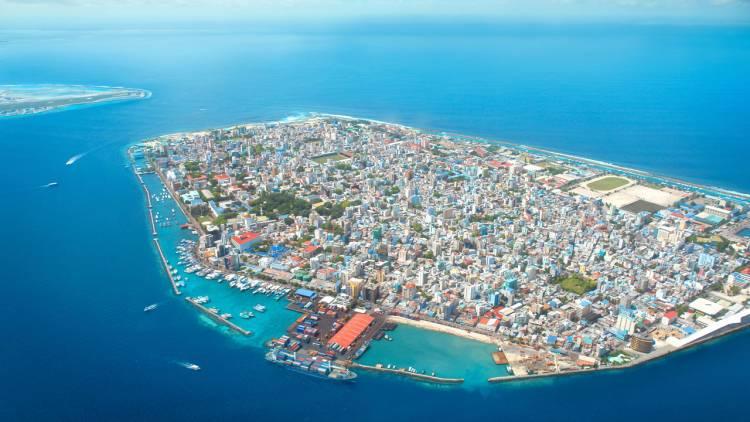
The entire nation won't be around for too much longer, and the president has recommended that those who can afford it start thinking about moving to nearby India or Sri Lanka. Recent tsunamis have already begun work making the islands uninhabitable - it's only a matter of time before nature does the rest. If you want to visit this paradise, the time is now. Otherwise you might find yourself surrounded by empty, sinking islands in a few years.
When it comes to extreme weather, Haiti has never been blessed with very good luck. In fact, some coastal towns, such as Gonaïves, are downright dangerous to visit. Gonaïves has been destroyed by storms time and time again, which have eradicated infrastructure, housing, land, and more importantly, many lives. One month, a total of four tropical cyclones hit the city, causing unimaginable crisis for the local people.
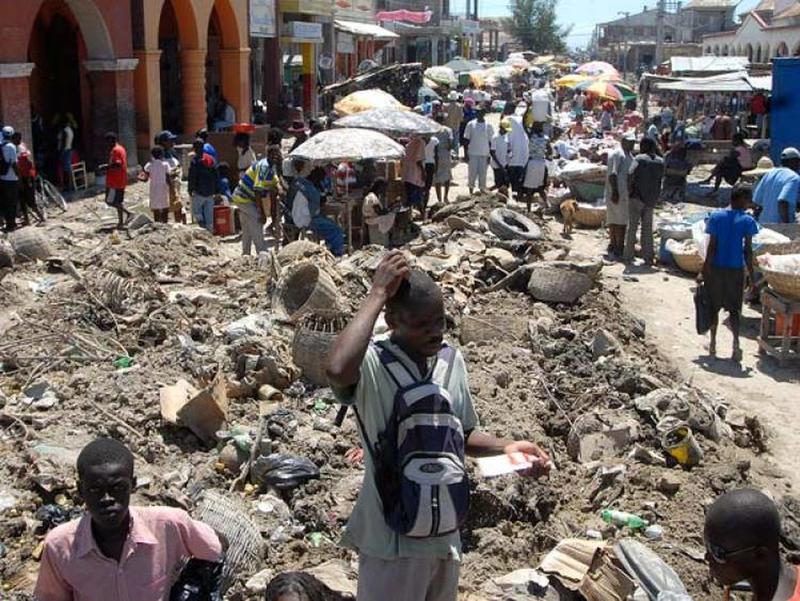
Hurricane Jeanne also played a big part in the increasing the danger, with a death toll of 3,000 people. In addition to this, Gonaïves sits on a flood plain, so any kind of storm seems to do more damage than you'd think. Deforestation in the area has also led to many dangerous mudslides. To summarize what we're trying to say, we recommend thinking long and hard before booking a beach break here!
It seems like no matter where you are in Indonesia, a threatening volcano is looming. On the island of Java, home to Indonesia's capital, Jakarta, the volcano in question is Mount Merapi. Its name translates to 'fire mountain' in English, and it's no wonder why. Mount Merapi is always releasing smoke into the sky, sometimes up to 10,000 feet high.
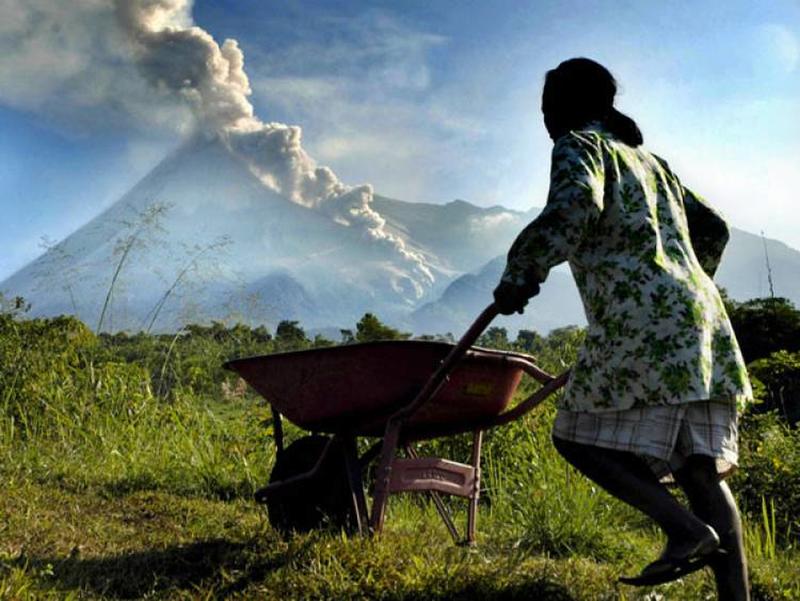
During its last eruption in 2006, Merapi caused 1,000 deaths as it spewed out eight square miles of lava around its base. Despite this, 200,000 people still live within a four-mile radius of the mountain. Given the fact that Indonesia is home to 22 active volcanos, it's kind of hard to escape them! Due to the unpredictable nature of Merapi, anyone who travels to this notorious fire mountain is seriously gambling with their own life.
We're sure not everyone is super interested in wind speeds, but if you are, you might like to know that Mount Washington in New Hampshire holds the record for fastest wind speed recorded, at 231 miles per hour. The weather up here is, to say the very least, erratic, with hurricane-force winds occurring, on average, around 110 days of the year.
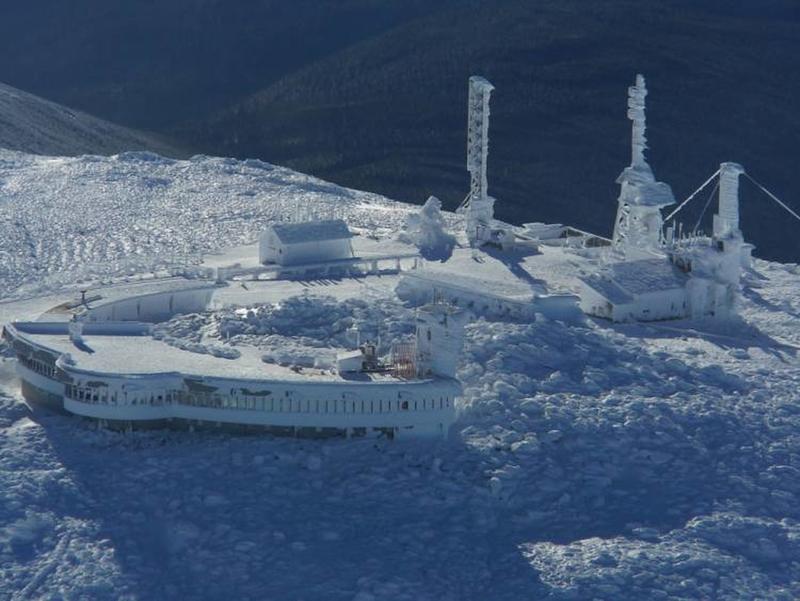
But the winds aren't the only thing visitors have to worry about. Freezing temperatures and seemingly constant heavy snowfall make Mount Washington an extremely inhospitable place - one you should definitely consider crossing off your itinerary if you're in the area. The experience at the top is not unlike the experience at the peak of Mount Everest, so perhaps consider enjoying other parts of the national park it's located inside instead. We hear it's very beautiful!
Do we really need to explain why visiting this island is a colossally bad idea? Known as Ilha da Queimada Grande in Portuguese, Snake Island is located off the coast of Brazil in the Atlantic Ocean. The place is teeming with one of the most venomous snakes in the world - the Bothrops viper. And we have to say, we're very relived they've all just decided to live isolated on this little island together.
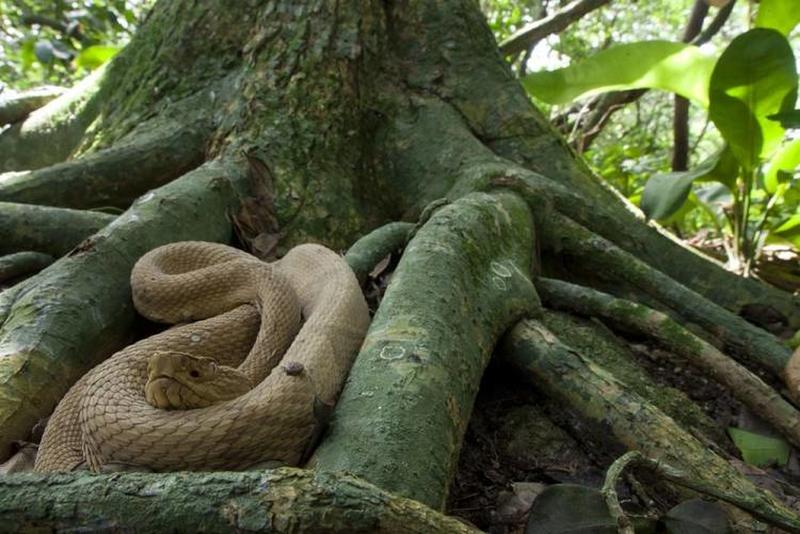
If it were possible, we're certain some adventurers would be taking the next boat out. But thankfully for everyone, including the snakes, the island is closed to the public. Due to their isolation and lack of predators, the species has multiplied at a rapid pace, to the point where the island is 100% uninhabitable for humans. The only people allowed out there are the Brazilian Navy.
Kamchatka, in Russia's far east, has its very own Death Valley, though it's quite different to its more famous partner in the USA. Due to its location close to the Valley of Geysers, high concentrations of very toxic gases are present and dangerous to anyone in the vicinity. Plants, birds, and animals simply cannot survive here, while humans have been known to get extremely ill with dizziness and fever after being exposed.
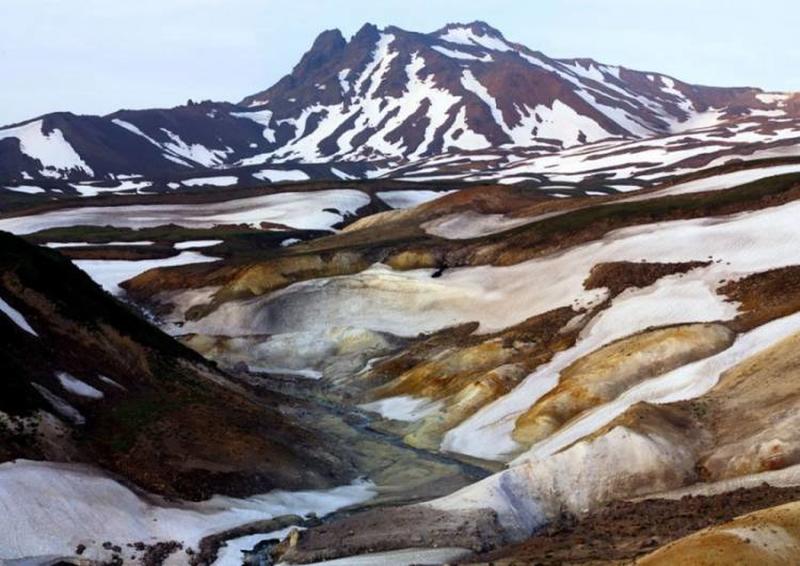
The poisonous gases, mostly comprised of hydrogen sulfide, carbon dioxide, and carbon disulphide tend to kill smaller creatures such as birds. Much larger animals, such as foxes, bears, and lynx die after eating the carcasses of the smaller animals. As long as humans evacuate the moment they feel the effects of the gases, they should survive, but we certainly wouldn't be risking it!
We're not sure why all of the killer lakes of the world seem to be located in Africa, but here's another one to add to the list. Lake Nyos in Cameroon, West Africa, contains a large amount of carbon dioxide within its depths. For many years, no harm was done, until 1986 when the carbon dioxide exploded upwards. This caused a huge carbon dioxide 'cloud' to form and it resulted in extreme destruction and death.

The cloud traveled downhill and effectively suffocated 1,700 people and many more animals. Basically, nothing survived for 15 miles. Today, things aren't as precarious as they once were, as pipes exist to siphon the carbon dioxide from the lake. The risk still hasn't been completely eradicated, but for the most part it's considered safe. We still wouldn't be booking our flights in a hurry.
This one is for all the Star Wars fans out there planning a visit to Tunisia. You may be familiar with Tatouine as the fictional village of Tatooine in George Lucas's Star Wars films. The Skywalker farm buildings were left there after filming and have since attracted thousands of Star Wars fans to the area. Unfortunately, it appears that the region is no longer safe for tourists to visit, so you may have to put your tour on hold for now.
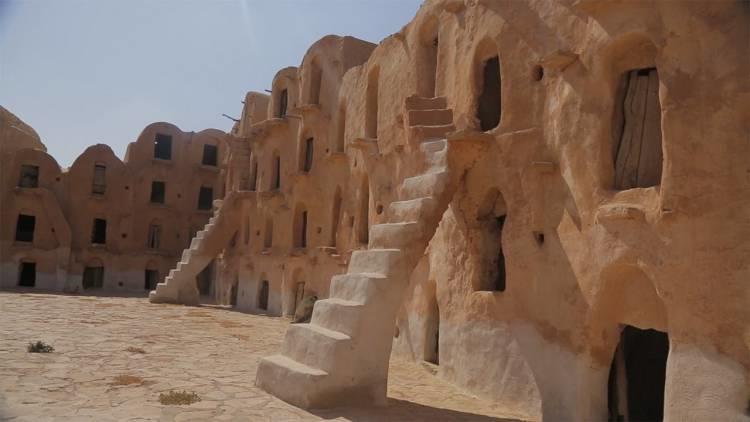
Recent terrorist activity in nearby Libya has made the area of Tatouine unstable, as it is in the path of traveling jihadists hoping to join infamous terrorist group, ISIS. Tourists have already perished in Tunisia, after an attack on the Bardo Museum in Tunis left 19 dead. Best to leave it until there's no further risk of attacks, we think.
Tucked away in south eastern France, the Gouffre Berger Cave is another one of those 'gorgeous but will probably kill you' attractions. If its nickname, "The Killer Cave" doesn't have you convinced, perhaps the fact that it's 3,681 feet deep will. It literally takes between 15 and 30 hours to return to the surface from the bottom of the cave. Within the cave are truly wonderful lakes and waterfalls, as well as structurally incredible caverns.

But heavy rainfall, combined with the lengthy amount of time it takes to exit the cave make exploration a recipe for disaster. Water rises fast, and there's no time to make it out of a flood. Cavers at Goueffre Berger have lost their lives, including an entire group of five in the '90s. If you value your life, maybe just check out the pictures online.
Arguably one of the most stunning regions of India, and perhaps the world, Kashmir is tragically unstable and poses a constant risk to tourists in the area. Civil unrest has plagued Kashmir to the point of closing for tourism in the past. But despite the warnings, there's always a bunch of eager travelers ready to enter whenever it reopens.
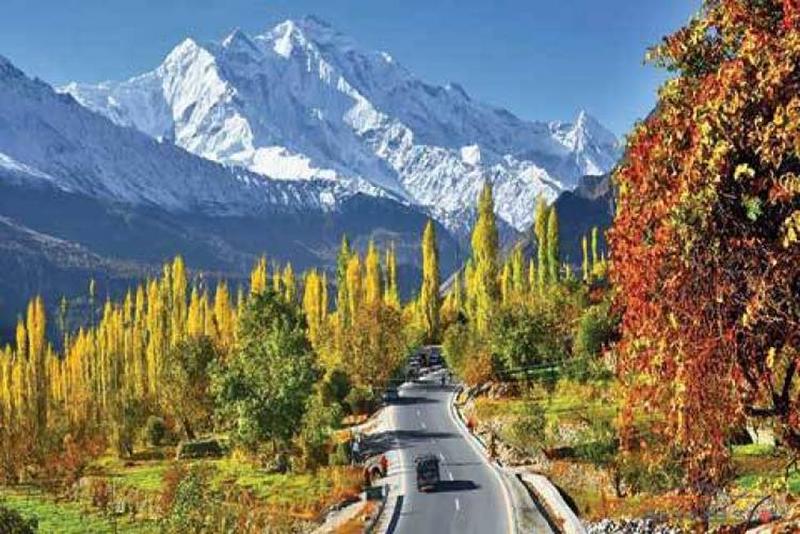
When it comes down to it, the conflict is mainly due to territorial issues. The people of Kashmir are majority Muslim and most would prefer to be independent, or at least part of Pakistan instead. But the area is important to the Indian government, so they probably won't be giving up the fight any time soon. If you don't want to get caught in any unpleasant and potentially deadly crossfire, we'd suggest visiting the Taj Mahal instead.
Renowned as one of the best whitewater rafting locations in the world, Futaleufu River certainly lives up to its English translation, 'big big river'. Rafting enthusiasts flock to the river to experience some of the most challenging rapids on earth, and most don't leave disappointed. The danger, however, is for inexperienced rafters who think they're ready to take on class V rapids (the second highest rating of rapids).
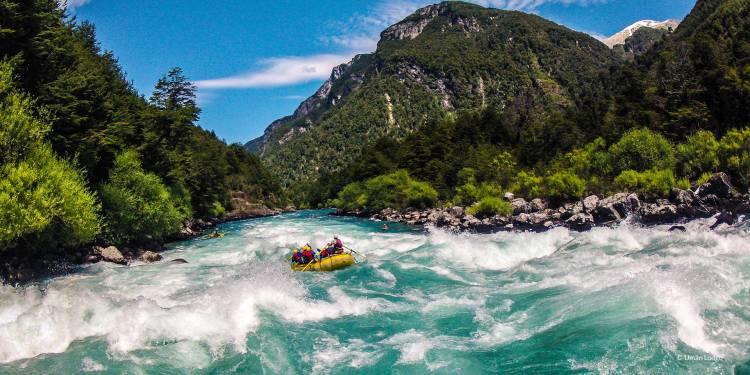
Whitewater rafters, as well as kayakers, have been known to die on the Futaleufu River - pulled underwater by the strong rapids and never seen alive again. It's a quick way to achieve a horrifying death, for sure. For us, we're happy with visiting our local aquatic center, or even a peaceful spring. There's no way we're getting taken down by a bunch of rapids and you shouldn't let them either!
Iceland's location on top of two tectonic plates makes it an incredible, geologically diverse environment. Home to 30 volcanos, the country is fairly used to them getting moody from time to time. Anyone who traveled or tried to travel to Europe in 2010 would be painfully familiar with Eyjafjallajokull Volcano. It grounded flights within the continent for weeks on end after an eruption spewed ash into the air, which posed a danger to airplane engines.
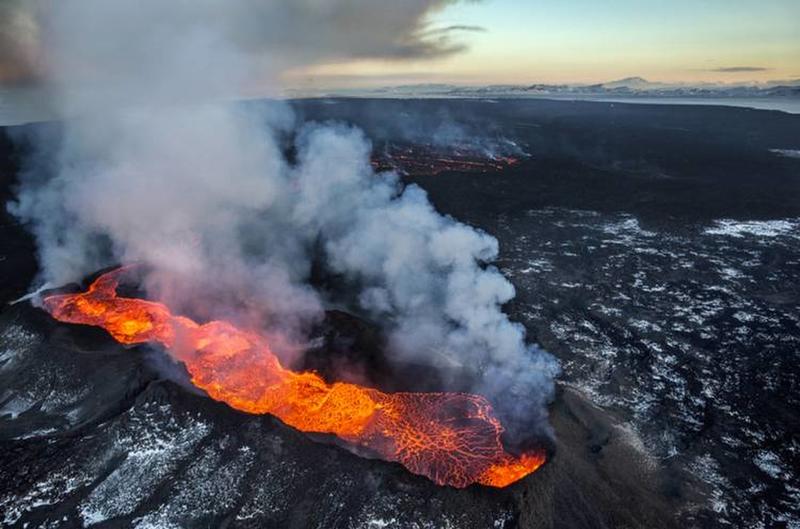
Baroarbunga Volcano is Iceland's second largest, and back in 2014 it started erupting again. Significant amounts of ash were not produced, which is why many people haven never even heard of it. But those who have done their research end up wanting to visit. We'd suggest being careful - the eruptions damaged Iceland's air quality with toxic sulphur dioxide and you never know when it might erupt again.
Home to a population of 13 million people, it's no surprise that there is a little bit of danger to dodge in Rio de Janeiro. With much of the Rio's locals living in favelas (like slums or shanty towns), poverty and crime are simply part of the city and have been for a long time. The divide between rich and poor is a big one, and it has definitely affected tourism.
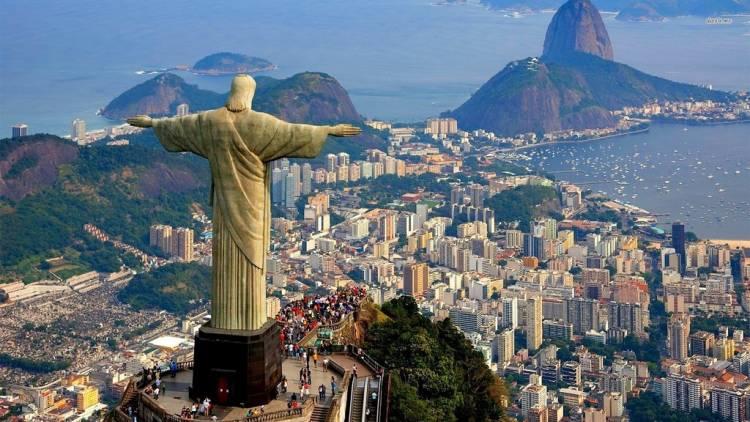
It seems like no tourist leaves Rio without a story about being mugged, pickpocketed, or assaulted on the streets. A few lucky ones get away with no major problems, but the reality is that they are the exception to the rule. While we wouldn't necessarily say your life is at risk, it's definitely a dangerous city to visit. It's up to you to decide if it's worth it.
The only thing standing in the way of completing the famous Pan-American Highway is the Darien Gap, which has been too dangerous to penetrate for decades and remains the missing link to this major road. Anyone who wishes to travel from Panama to Colombia must fly or take a boat, as there's no way you can make the journey by land, unless you have a death wish.
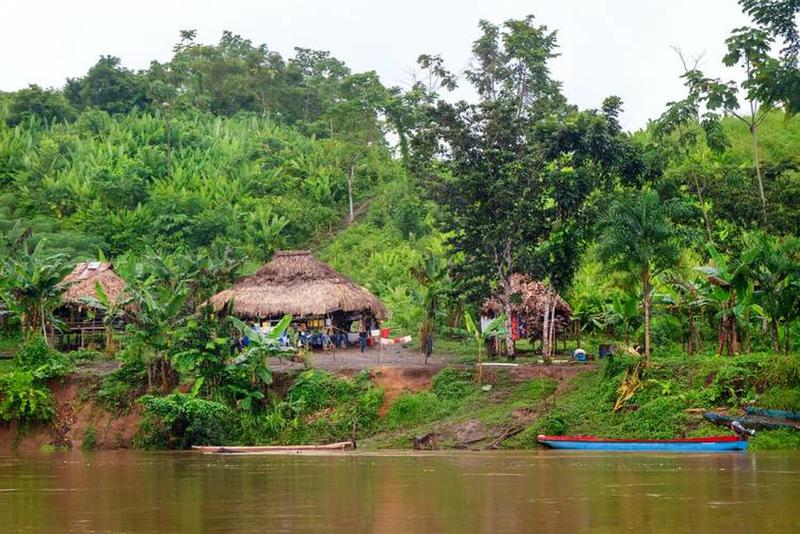
For years, the area has been inhabited by Colombian paramilitary, hostile tribes, dangerous wildlife, and questionable terrain, making it one big danger cocktail. Some adventurers have made the treacherous journey, but others haven't gotten to the other side alive. Though paramilitary activities have calmed down a little in recent times, we still wouldn't risk a sudden kidnapping or a meeting with a territorial tribe. Try visiting one of Panama or Colombia's safer national parks instead.
You know it's bad when an attraction in Southeast Asia is forced to close down for safety reasons. Previously known as the world's most terrifying tourist attraction, Elephant Kingdom in Chonburi is certainly not for the faint-hearted. Before being shut down due to shocking images of it circulating online, Elephant Kingdom was a real death trap.
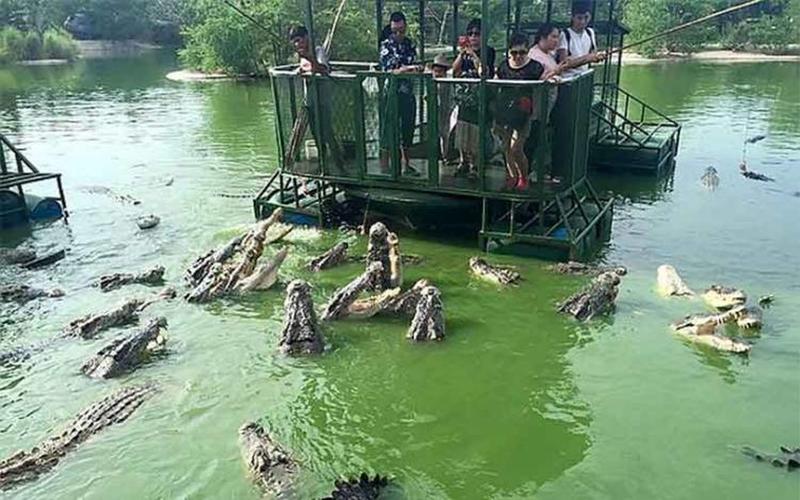
Tourists, including families with children, would dangle bits of meat over a crocodile-infested river. To make things worse, they weren't even in a big boat or anything resembling a safe vehicle for this kind of activity - the best word we can come up with for it is 'floating cage'. These deadly, three-meter long crocs would jump high in the air to snatch up the meat. With tourists only centimeters away, it was a nightmare just waiting to happen.
At a size of 1.2 million acres, is it any wonder that things end up going wrong? Arizona's famous Grand Canyon National Park is one of the world's most popular tourist destinations. But it's also one of the deadliest. Visitors to the park will battle soaring temperatures and dehydration, or sub-zero cold. There seems to be no happy medium when it comes to this wild stretch of desert.
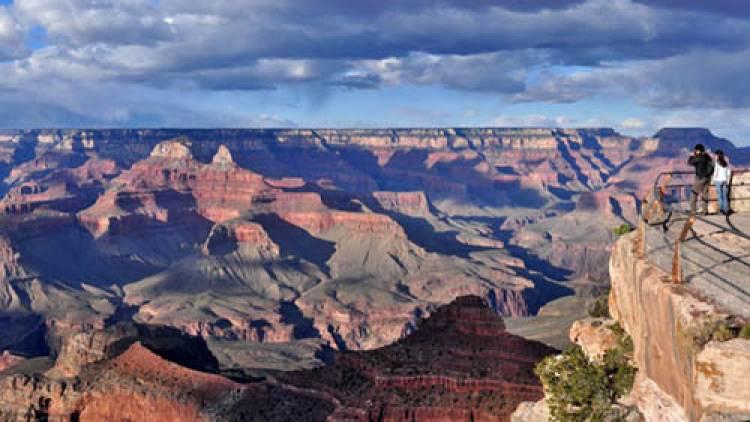
Deaths occur for a whole range of reasons out here. Cardiac arrests are common, as well as accidental falls and dehydration. What most people don't know is that the Grand Canyon is one of the most famous suicide spots in the world, and they're increasing every year. There are certainly plenty of ways to visit the canyon and make it out alive, so we'd recommend you take one of those instead of doing anything risky.